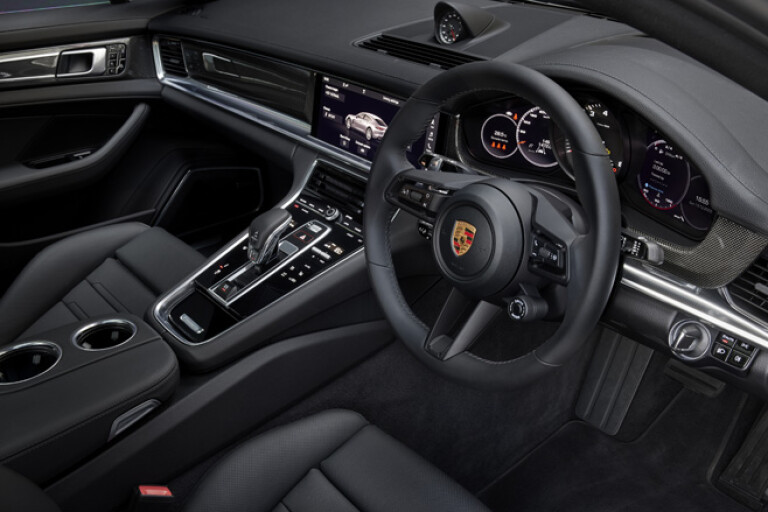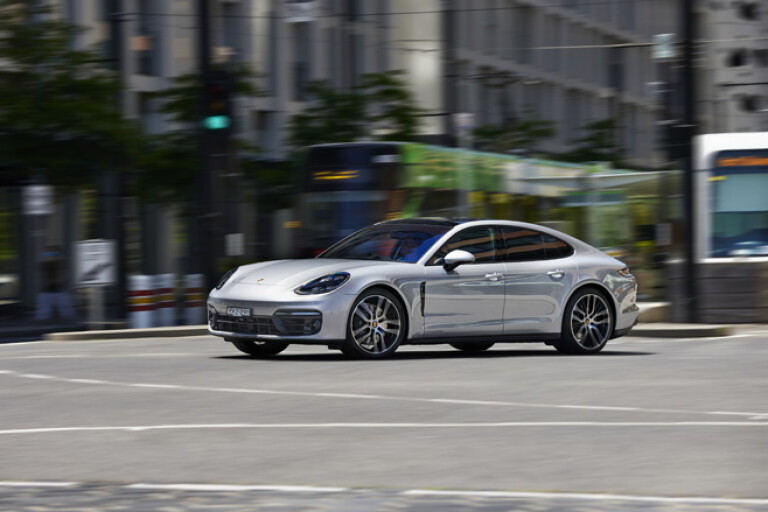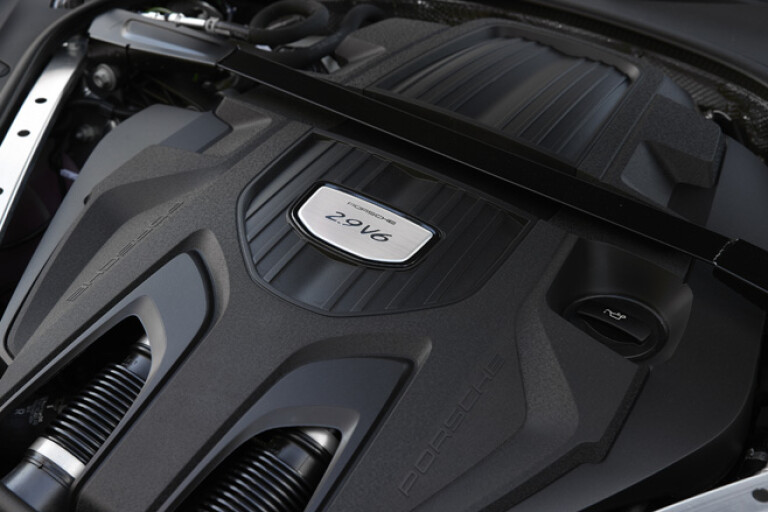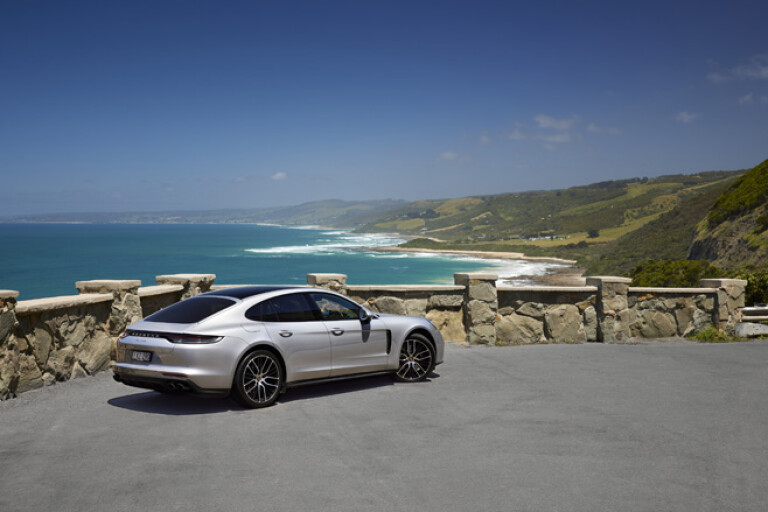
The latest Porsche Panamera facelift isn’t exactly extensive – even Porsche itself describes it as “very mild”.
It mainly consists of a couple of new variants such as the V8 GTS, petrol-only Turbo S, more powerful 4S E-Hybrid and a long-wheelbase ‘Executive’ option for the Panamera 4, but it also gives us a chance to slide behind the wheel of the ‘base model’ Panamera.
That’s not a particularly accurate descriptor of a car that starts at $199,500 before options or on-roads, but the fact remains that this is the lowest rung on the Panamera ladder. Porsche has not left it idle, however, bolstering the value case with extra equipment.
The Panamera now includes LED matrix headlights including PDLS Plus (active cornering headlights), Power Steering Plus (speed-sensitive power steering), ventilated front seats, lane change assist, a head-up display and soft-close doors, so it’s an impressive amount of added kit.

Certainly from behind the wheel there is little to no hint that you’ve restrained from scaling higher up the Panamera pecking order. The cabin is awash with beautiful clever and sexy carbon, all the technology – infotainment, driving and safety – seems present and correct (in part thanks to the update) and there are very few blank spaces in place of buttons which usually serve as a dead giveaway that you’ve skimped on the spend.
There is also masses of room, which goes some way to answering the first question that popped into my head when testing the Panamera: “why wouldn’t you just buy the faster, cheaper, cooler, newer Taycan 4S?” Space is at a premium in Porsche’s electric rocket ship, the Panamera having more room than its slight dimensional advantage suggests.
The two are quite similar in size, the Panamera being 86mm longer, 29mm narrower and 44mm taller to accommodate four large adults with ease. Luggage space is also superior at 495 litres with the rear seats in place and 1334 litres with them down, compared to the Taycan’s 407L boot and 81L ‘frunk’ in the nose.

The Panamera doesn’t drive like a base model either. In some cars, even high-end ones, there is a clear progression as you climb towards the top of the tree but essentially the entry Panamera feels exactly the same as the range-topping Turbo S in terms of its controls.
Air suspension is standard on all Aussie Panameras and the ride quality is excellent, with only the occasional jostle over poor surfaces. The Panamera isn’t a magic carpet in the manner of a Mercedes S-Class as there’s a degree of firmness at urban speeds but it’s more a connection to the road than a source of discomfort.
Porsche plans hero hybrid Panamera with more than 500kW
Dual-clutch gearboxes can struggle with smooth slow-speed operation but the Panamera manages to avoid this in the main, though there is the occasional thump if you catch it unawares. Just as the ride smooths out at higher speeds, so too does the gearbox slip quickly and seamlessly through the gears once rolling.

So far, so good, but where the Panamera really comes into its own is when the going gets twisty. Granted, it’s never going to be your first choice from Porsche’s catalogue when it comes to a mountain thrash but it is ridiculously capable when being hammered.
Massive Michelin Pilot Sport 4 S tyres help, our test car’s boots measuring 275mm wide front and 315mm rear, so grip is fairly impressive, but you can dance on the edge of that grip in a way you probably wouldn’t expect from such a big car.
It doesn’t get at all ruffled or upset if you suddenly think you’re in a Cayman and it’s only when you really commit to corners that you realise that its talent reserves are deeper than you first thought.

Granted, its size and weight limit your options somewhat – don’t try and abruptly change your mind mid-corner, for instance – but it’s still incredibly impressive.
2018 Porsche Panamera Turbo Sport Turismo vs Mercedes-AMG S63 L
The one downside to choosing the entry Panamera is that you don’t really have the power to exploit this capability. In isolation the 2.9-litre twin-turbo V6 is a fine engine; its revs keenly, has plenty of mid-range torque and even sounds good once Sport mode is engaged. But there are a couple of drawbacks.
It uses the grunt it does have to good effect with a 0-100km/h claim of just 5.4sec (when optioned with Sport Chrono; 5.6sec otherwise) but 243kW/450Nm isn’t that much in an 1860kg car. Furthermore, there’s a distinct hesitation when you catch the engine off-guard, such as between corners when you snap the throttle shut then ask for full power once again.

It’s here that the Taycan has the advantage for keen drivers with masses of instant electric torque available, but the Panamera probably just shades it for overall driver appeal. It’s also a simply beautiful cruiser, built to dispatch mega distances at mega speeds, an ability that Australia’s speed limits sadly render largely redundant.
Even this entry-level Panamera is a very desirable car and if you’ve always wanted a family-friendly Porsche then you’re unlikely to be disappointed. But if you have the means it’s easy to recommend leaning into the whole combustion engine thing and looking further up the range.
The New Porsche Panamera is the fastest “executive car” at the Nurburgring
The monster 463kW/820Nm Turbo S and its 3.1sec 0-100km/h sprint is obviously tempting, but an eye-watering $409,200 price tag does take the shine off somewhat. As such, the new GTS could well be the sweet spot, with its luscious 353kW/620Nm 4.0-litre twin-turbo V8 and even sharper dynamics. It’s available in ‘Sport Turismo’ wagon guise, too, for even more practicality and cool factor.

We’ll confirm this when we review the rest of the updated Panamera range in due course.
Verdict: 8.5/10
Likes: improved value; fabulous dynamics; interior quality; space
Dislikes: chassis deserves more grunt; engine response; ride not absolutely perfect
2021 Porsche Panamera Specifications
Body: 5-door, 5-seat hatch
Drive: rear-wheel
Engine: 2894cc V6, DOHC, 24v, twin-turbo
Bore/stroke: 84.5 x 86.0mm
Compression: 10.5:1
Power: 243kW @ 5400-6400rpm
Torque: 450Nm @ 1800-5000rpm
0-100km/h: 5.6sec (5.4sec w/Sport Chrono)
Fuel consumption: 8.8L/100km (combined/claimed)
Top Speed: 270km/h
Weight: 1860kg
Power/weight: 131kW/tonne
Transmission: 8-speed dual-clutch
Suspension: double wishbones, air springs, adaptive dampers, anti-roll bar (f)’ multi-links, air springs, adaptive dampers, anti-roll bar (r)
L/W/H: 5049/1937/1423mm
Wheelbase: 2950mm
Tracks: 1671/1651mm
Steering: electrically assisted rack-and-pinion
Brakes: 350mm ventilated discs, 6-piston calipers; 330mm ventilated discs, 4-piston
Wheels: 21 x 9.5-inch (f); 21 x 11.0-inch (r)
Tyres: 275/35 ZR21 (f); 315/30 ZR 21 (r)
Price: $199,500

COMMENTS